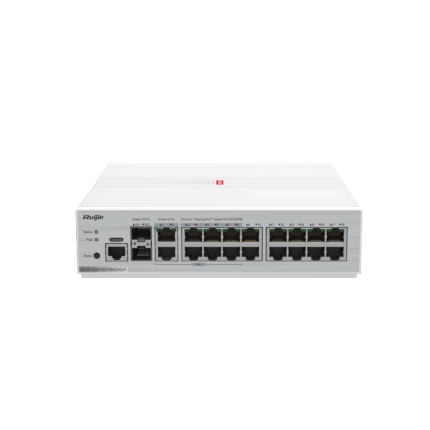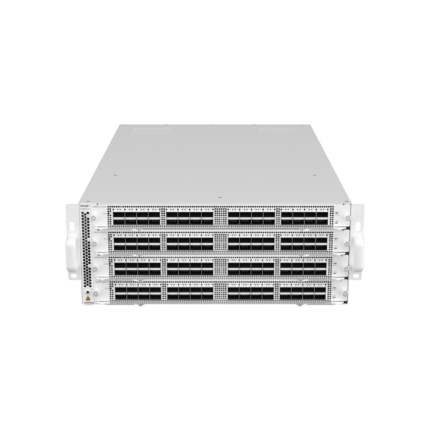Description
Multi-GE Access
In recent years, Ethernet interface standards have rapidly evolved from 10BASE-T and 100BASE-T to 1000BASE-T (IEEE 802.3ab), leading to widespread adoption across devices such as PCs and APs. However, as the Wi-Fi 6 technology has been introduced, APs can now deliver uplink rates of 10 Gbps, which poses a growing challenge for GE network devices. The RG-S6100 addresses this issue by offering 100M/1000M/2.5G/5G Base-T and 100M/1000M/2.5G/5G/10G Base-T Ethernet ports in auto-negotiation mode, providing better adaptability to Wi-Fi 6 APs.
High-Power PoE Power Supply
Previously, PoE remote power supply scenarios only have access to PoE (IEEE 802.3af) and PoE+ (IEEE 802.3at) standards. However, if the power exceeds 30 W, users are unable to use PoE for power supply, opting instead for mains-powered cables or even high-voltage power deployment. This presents significant challenges related to deployment costs and timelines, maintenance, and security. By adhering to the IEEE802.3bt standard, the RG-S6100 offers high-power PoE power supply capabilities and achieves a maximum PoE output of 90 W through a single Ethernet port, providing a significantly improved user experience.
IPv4/IPv6 Dual-Stack Multi-Layer Switching
The RG-S6100 hardware supports both IPv4 and IPv6 dual stacks, as well as multi-layer line-rate switching in order to differentiate and process packets of each protocol effectively. With flexible IPv6 network communication solutions, the RG-S6100 can meet various IPv6 network demands such as planning or maintenance. The RG-S6100 supports a wide range of IPv4 routing protocols, covering IPv4 static routing, RIP, OSPFv2, IS-ISv4, and BGP4. Fitting for different network environments, one can select appropriate routing protocols for flexible network building. Additionally, the RG-S6100 also supports abundant IPv6 routing protocols such as IPv6 static routing, RIPng, OSPFv3, IS-ISv6, and BGP4+. These protocols can be flexibly selected to either upgrade an existing network to IPv6 or establish a new one.
VSU
The RG-S6100 supports Virtual Switching Unit (VSU). VSU enables multiple physical devices to be connected through aggregate links and virtualized into one logical device. By using the same IP address, Telnet process, and CLI for management, along with automatic version check and configuration, network administrators can manage just one logical device, thereby enhancing work efficiency.
Simplified management: The network administrator can manage multiple switches uniformly because there is no need to connect separately to each switch for configuring and managing them.
Simplified network topology: A VSU serves as a switch within a network and eliminates Layer 2 loops and MSTP configurations by connecting peripheral devices through aggregate links. Various control protocols can run on the VSU.
Fault rectification within milliseconds: A VSU connects to peripheral devices through aggregate links. If a fault occurs on one device or member link in the VSU, data and services can be switched to another member link within 30 ms.
High scalability: Devices can be added to or removed from a virtualized network, without affecting normal operation of other devices.
Sound Security Protection Policies
The RG-S6100 can effectively defend against virus spread and hacker attacks through multiple inherent mechanisms, such as DoS attack defense, IP scanning attack defense, validity check of ARP packets, and multiple hardware-based ACLs.
The hardware-based IPv6 ACL can easily control the access of IPv6 users at the network edge even if there are IPv6 users on an IPv4 network. The RG-S6100 allows IPv4 and IPv6 users to coexist and can control access permissions of IPv6 users, for example, restricting access to sensitive resources on the network.
The RG-S6100 provides a unique hardware CPU protection mechanism: CPU Protection Policy (CPP). CPP enables the RG-S6100 to classify data traffic sent to the CPU, process the traffic by queue priority, and apply the rate limit to traffic as required. CPP fully protects the CPU from being occupied by unauthorized traffic, malicious attacks, and resource consumption, which ensures the security of the CPU and the switch.
The RG-S6100 and its ports can be flexibly bound to a user’s IP address and MAC address, which strictly restricts the access of users connected to the ports or the switch.
DHCP snooping enables the RG-S6100 to receive DHCP Response messages only from trusted ports, preventing spoofing from unauthorized DHCP servers. With DHCP snooping, the RG-S6100 dynamically monitors ARP packets, checks users’ IP addresses, and discards unauthorized packets that do not match binding entries. This effectively prevents ARP spoofing and source IP address spoofing.
The RG-S6100 also supports access control through source IP address-based Telnet, which can prevent unauthorized users and hackers from maliciously attacking and controlling the switch, and enhance the network management security of the switch.
Through the Secure Shell (SSH) and Simple Network Management Protocol version 3 (SNMPv3), the RG-S6100 can encrypt management information in Telnet and SNMP processes. This ensures information security of management devices and prevents hackers from attacking and controlling the devices.
The RG-S6100 rejects unauthorized network access and enables authorized network access by employing multi-element binding, port security, time-based ACL, and data stream-based rate limiting. It can strictly control user access to enterprise networks and campus networks and restrict the communication of unauthorized users.
The RG-S6100 supports the Network Foundation Protection Policy (NFPP) to enhance its security. By isolating attack sources, NFPP can protect the processor and channel bandwidth resources of the switch. This ensures normal packet forwarding and protocol status.
High Reliability
The RG-S6100 supports built-in redundant power modules and fan modules. The power and fan modules are hot swappable without affecting the normal operation of the switch. The switch also provides fault detection and alarms for power and fan modules. The fan speed can be automatically adjusted based on temperature changes to better adapt to various environments. The RG-S6100 adopts the front-to-rear airflow to enhance the cooling efficiency. By using overcurrent, overvoltage, and overheating protection technologies, the RG-S6100 achieves device-level and link-level reliability protection.
The RG-S6100 supports STP (IEEE 802.1D), RSTP (IEEE 802.1w), and MSTP (IEEE 802.1s) to achieve fast convergence, improve the fault tolerance capability, and ensure stable network operation and link load balancing. The RG-S6100 effectively utilizes network channels to improve the usage of aggregate links.
The Virtual Router Redundancy Protocol (VRRP) ensures network stability for the switch.
With the Rapid Link Detection Protocol (RLDP), the RG-S6100 can quickly detect link connectivity and unidirectional optical links. Through port loop detection, the switch can prevent network failures caused by the loops that occur in the scenario where an unauthorized port is connected to hubs.
When STP is disabled, the Rapid Ethernet Uplink Protection Protocol (REUP) can still provide basic link redundancy and millisecond-level fault rectification faster than STP.
The RG-S6100 supports Bidirectional Forwarding Detection (BFD) for upper-level protocols (such as routing protocols), rapidly detecting connectivity of the forwarding path between two routing devices. BFD greatly shortens the convergence time for upper-level protocols upon link status changes.
Powerful Multi-Service Capability
The RG-S6100 supports IPv4 and IPv6 multicast functions as well as multiple multicast protocols, including IGMP snooping, IGMP, Multicast Listener Discovery (MLD), Protocol Independent Multicast (PIM), PIM for IPv6, and Multicast Source Discovery Protocol (MSDP). It provides multicast service support for IPv4 networks, IPv6 networks, and IPv4 and IPv6 networks.
IGMP source port check and source IP address check supported by the RG-S6100 can effectively eliminate unauthorized multicast sources and enhance network security.
Sound QoS Policies
The RG-S6100 can classify and control various flows, such as MAC flows, IP flows, and application flows, to implement different policies such as fine-grained bandwidth control and forwarding priority. In this way, it provides differentiated services based on applications and characteristics of service quality required by the applications.
It provides QoS guarantee based on the DiffServ model, and can filter traffic based on 802.1p priorities and IP ToS values, and from Layer 2 to Layer 7. It supports SP, WRR, and other QoS policies.
Energy Saving
The RG-S6100 adopts the next-generation hardware architecture, and advanced energy-efficient circuit design and components, to efficiently reduce energy consumption and noise. It is equipped with variable-speed axial fan modules to intelligently control the fan speed based on the ambient temperature. This reduces power consumption and noise while ensuring stable operation of the switch.
In the networking where PoE power supply is adopted, the RG-S6100 provides automatic and energy-saving modes.
Easy Network Maintenance
The RG-S6100 supports routine network diagnosis and maintenance based on SNMP, RMON, Syslog, and USB-based backup log and configuration. A network administrator can use various management and maintenance modes such as command line interface (CLI), web network management, and Telnet to facilitate device management.
A PoE button is available on the panel of the switch. You can press this button to check the communication status and PoE status of all ports on the switch.
















Reviews
There are no reviews yet.